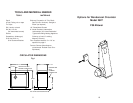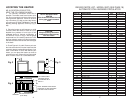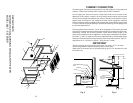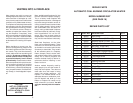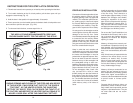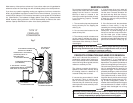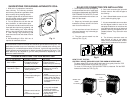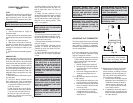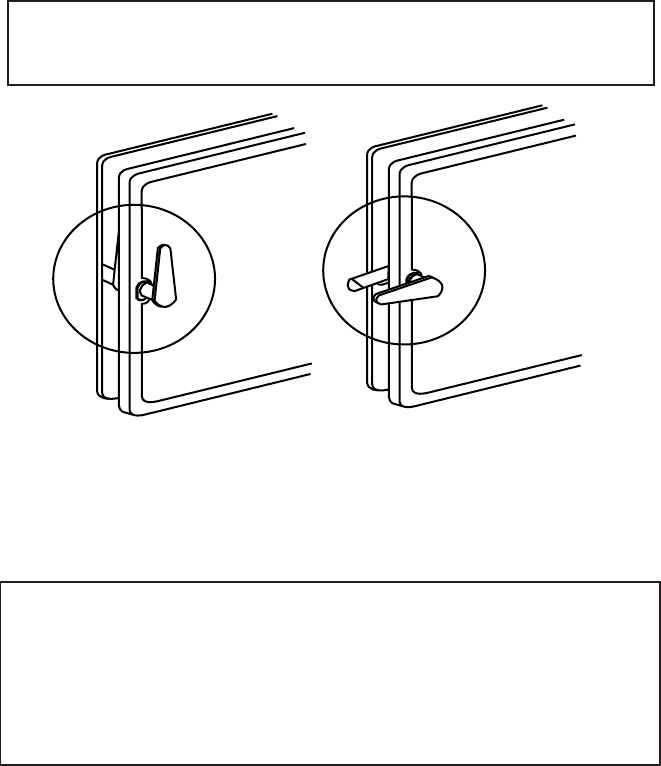
FIREPLACE INSTALLATION
Connection of the stovepipe directly into
the existing masonry chimney over the
fireplace opening is the only approved
method. This installation performs bet-
ter, yielding easy to clean and inspect
for creosote. Before beginning this type
of installation plan carefully; a high de-
gree of skill is required to insure safety.
An entry port for the stovepipe must be
cut through the chimney with minimum
damage to the fire clay liner. Some
involved measurements may be required
to locate the flue liner exactly. Before
cutting, take time to mark the size and
position of the entry port. Position the
entry port so that at least 8 inches of the
flue liner remains below the port.
Keep in mind that coal mantels and
combustible trim around the fireplace
must have adequate clearances from
the heater and stovepipe or must be
protected in an approved manner. Also,
be sure to leave at least 24" clearance
between the top of the stovepipe and
the combustible ceiling or other com-
bustibles. Placing the center of the entry
port 2 feet below the ceiling will insure
proper clearance for 6 inch, 8 inch, and
10 inch stovepipes. Next, install a fire
clay (at least 5/8 in. thick) or metal
thimble, being sure that the thimble is
flush with the inner flue lining, secure
the thimble in place with refractory mor-
tar. The thimble should be surrounded
on all sides with 8 inches of brickwork
(solid masonry units) or 24 inches of
stone.
7
INSTRUCTIONS FOR TWO-STEP LATCH OPERATION
1. Follow these instructions to operate you unit safely when operating the feed door.
2. Turn handle clockwise to the 12 o'clock position, pull the door open until you
engage the second step (Fig. 12).
3. Hold the door in that position for approximately 10 seconds.
4. Then to open door, turn the handle counter clockwise to the 9 o'clock position and
then continue to pull the door open. (Fig. 12A)
5. To close and latch the door, reverse steps 2 thru 4.
NOTE:
THIS NEW LATCHING MECHANISM MEETS CODES AND
PROVIDES MORE SAFETY FOR THE USER OF THIS STOVE.
14
NOTE:
DURING OPENING AND CLOSING OF THE FEED AND ASH DOORS
OF THIS HEATER, IT MAY SEEM THAT THE FIT OF THE DOOR IS
"TOO TIGHT". AS THE HEATER IS FIRED, THE GASKETING
"SETTLES" OR "SEATS" ITSELF IN THE DOOR. THE TIGHT FIT AT
THE FACTORY AND BEFORE THE HEATER'S INITIAL FIRING IS TO
INSURE A GOOD SEAL AFTER THE GASKETING "SETTLES".
Install the stovepipe as far as possible
into the thimble, but not past the inside
of the flue lining. There should be a
small airspace (approximately 1/2 inch)
between the stovepipe and thimble,
allowing for expansion of the stove-
pipe. Seal this airspace with high-tem-
perature caulking or ceramic wool. Fi-
nally, be sure to wire the damper close
and apply the same sealant you used at
the stovepipe and thimble junction.
Do not use the Type B installation (not
illustrated in this manual), that is, vent-
ing up through the fireplace opening,
regardless of whether the fireplace
opening is closed.
Masonry chimneys have several posi-
tive attributes: If properly built, they are
quite durable, and most homeowners
consider them more attractive perhaps
than a non-enclosed factory built chim-
ney.
And, if the chimney is located within the
confines of the house (that is, not at-
tached to an exterior wall), its mass
alone will store heat longer and con-
tinue to release the heat long after the
fire has died. Masonry chimneys have
many disadvantages though.
Masonry chimneys constructed on an
exterior wall are exposed to cold out-
door temperatures, promoting greater
heater loss, higher accumulations of
creosote, and reduced draft which leads
to poorer heater or furnace perfor-
mance.
Concrete block chimneys (when not
protected by a brick veneer) are inher-
ently unsafe, result in poor draft, and are
subject to rapid deterioration. They do
not meet code and are not recom-
mended.
Fig. 12
Fig. 12A




